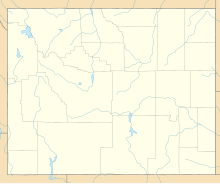Jackson Hole Airport
| Jackson Hole Airport | |||||||||||
|---|---|---|---|---|---|---|---|---|---|---|---|
 |
|||||||||||
| Summary | |||||||||||
| Airport type | Public | ||||||||||
| Owner | Jackson Hole Airport Board | ||||||||||
| Serves | Jackson, Wyoming | ||||||||||
| Elevation AMSL | 6,451 ft / 1,966 m | ||||||||||
| Coordinates | 43°36′26″N 110°44′16″W / 43.60722°N 110.73778°WCoordinates: 43°36′26″N 110°44′16″W / 43.60722°N 110.73778°W | ||||||||||
| Website | www |
||||||||||
| Map | |||||||||||
| Location of airport in Wyoming / United States | |||||||||||
| Runways | |||||||||||
|
|||||||||||
| Statistics (2010) | |||||||||||
|
|||||||||||
|
Sources: airport web site and Federal Aviation Administration
|
|||||||||||
| Aircraft operations | 25,601 |
|---|---|
| Based aircraft | 52 |
Jackson Hole Airport (IATA: JAC, ICAO: KJAC, FAA LID: JAC) is a United States public airport located seven miles (11 km) north of Jackson, in Teton County, Wyoming. In 2014, it was the busiest airport in Wyoming by passenger traffic with 313,000 passengers. During peak seasons, Jackson Hole has nonstop airline service from 13 destinations throughout the United States including New York–JFK, Chicago–O'Hare, and Los Angeles International Airport. During shoulder seasons, airline service is limited to the nearby hubs of Salt Lake City and Denver. The airport is served year-round by Delta Connection and United Express and seasonally by Delta (mainline), United (mainline) and by American.
Jackson Hole Airport is the only commercial airport in the United States located inside a national park, in this case Grand Teton. (The Provincetown Municipal Airport in Massachusetts is on land leased from the National Park Service, but it is not in a national park.)
The airport was created in the 1930s as the best place to put an airport in Teton County. The airport was declared a national monument in 1943, and merged with Grand Teton National Park in 1950. The runway was extended to its current length in 1959. In the 1960s and 1970s a runway extension to 8,000 feet (2,400 m) to allow jets was considered; the National Park Service successfully opposed it. In the late 1970s jets began using the existing runway. The area is noise sensitive and the airport allows no jets louder than stage III. The airport is a popular mating ground for the rare Sage Grouse.
...
Wikipedia


